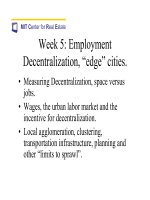Tài liệu The housing MarkeT and Canada’s eConoMiC reCovery ppt
Bạn đang xem bản rút gọn của tài liệu. Xem và tải ngay bản đầy đủ của tài liệu tại đây (3.03 MB, 19 trang )
THE HOUSING MARKET
AND CANADA’S
ECONOMIC RECOVERY
January 2012
www.fcm.ca
For more information contact Leanne Holt, Policy Advisor, at or 613-907-6234.
Principal researcher and contributing author: Marni Cappe MCIP, RPP
©2011 Federation of Canadian Municipalities.
All rights reserved.
Federation of Canadian Municipalities
24 Clarence Street
Ottawa, Ontario K1N 5P3
www.fcm.ca
SINCE / DEPUIS 1
901
1
Prepared for FCM by Steve Pomeroy, Focus Consulting Inc./University of Ottawa
Centre on Governance.
The Federation of Canadian Municipalities (FCM) has been the national voice of
municipal government since 1901. With close to 2,000 members, FCM represents
the interests of municipalities on policy and program matters that fall within
federal jurisdiction. Members include Canada’s largest cities, small urban and
rural communities, and 21 provincial and territorial municipal associations.
©2012 Federation of Canadian Municipalities.
All rights reserved.
Federation of Canadian Municipalities
24 Clarence Street
Ottawa, Ontario K1N 5P3
www.fcm.ca
The Housing Market and Canada’s Economic Recovery 1
Table of Contents
Executive Summary 2
Housing and the Economy 4
Rental Housing and Economic Recovery 6
Barriers to Rental Market 7
Growth and Rental Demand 8
Increased Market Supply and Affordable Housing 10
Municipalities Respond 11
Moving Forward 12
Conclusion 15
2 The Housing Market and Canada’s Economic Recovery
Executive Summary
A healthy housing sector, able to meet a broad range of needs, is
a vital part of the economic and social wellbeing of any commu-
nity. Whether they are recent college graduates, new immigrants,
or senior citizens, Canadians at various income levels and stages
of life have different housing needs. To build a strong economy,
healthy communities, and a mobile workforce, our housing market
must be able to accommodate changing needs.
Canadians are feeling the strain of increasing costs of home owner-
ship. They are also feeling the impact of decades of low levels of
purpose-built rental accommodation, low vacancy rates, and rising
rents. Meanwhile, a surge in the building of new condominiums has
tended to push multi-residential land values up, further worsening
the prospects for rental development.
High home prices, fueled in part by low mortgage rates, have con-
tributed to the taking-on of high levels of debt by many households,
and there may now be an imbalance in Canada’s housing system.
Canada’s home-price-to-rent ratio is at an all-time high. At the same
time, new housing starts remain well below previous averages. The
dramatic decline from 228,343 in 2007 to 149,081 in 2009, follow-
ing the global financial crisis in 2008–2009, has resulted in the
loss of 50,000 construction jobs, and a serious impact on both the
construction sector and the economy. While starts have rebounded
slightly, they are still well below the peak.
Current fiscal challenges facing all orders of government highlight
the need to explore innovative and low-cost near-term solutions,
in order to address persistent housing problems in communities
across the country.
Although Canada’s rental sector plays a critical part within a healthy
housing system, it has been largely overlooked. Measures to cre-
ate new rental housing, while also retrofitting what already exists,
will help address a weakening housing system and contribute to a
healthy economy.
The Housing Market and Canada’s Economic Recovery 3
The Federation of Canadian Municipalities (FCM) is proposing three
initiatives designed to lower barriers to private-sector investment in
rental housing; to stimulate the construction of new rental housing
and retrofits; and to preserve existing affordable rental stock.
Increasing the construction of rental housing will protect construc-
tion jobs in the future. Canada cannot count on another boom in the
new-housing market to replace jobs already lost. The fundamentals
that supported growth in home ownership—declining mortgage
rates, extended mortgage terms, low down payments, and a strong
economic outlook—have ended.
Nor can we rely solely on home ownership to meet Canadians’
housing needs. For many Canadians, the cost of buying a home
has become prohibitive. Average costs for single detached homes
doubled between 2001 and 2010, while household incomes have
not kept up. At the same time, the Bank of Canada has warned
about the historically high personal debt loads carried by Canadian
households,
1
with mortgages making up 68% of this debt.
2
We have entered a period during which a growing number of
Canadians will need access to rental accommodation.
All orders of government must work with the housing sector, in
order to provide a balanced mix of housing options able to meet
the long-term financial realities of a changing population. New
demographics include young people entering the rental market;
new immigrants, who are sorely needed to fill labour gaps; a more
mobile labour force; and Canada’s aging population, which is pro-
jected to downsize and save for retirement.
1 Canadian Press, “IMF warns about Canadian household debt, housing prices”,
December 22, 2011, CTV on-line />warns-household-debt-housing-prices-111222/
2 CMHC, Canada Housing Observer, 2011 p.35
4 The Housing Market and Canada’s Economic Recovery
The Federation of Canadian Municipalities (FCM) is proposing the
following three initiatives:
1. The Building Canada Rental Development Direct Lending
Program to stimulate investment in new market-priced rental units.
2. The Rental Housing Protection Tax Credit to preserve and
stop the serious erosion—through demolition and conversion to
condominiums—of existing lower-rent properties.
3. The Eco-Energy Rental Housing Tax Credit to improve the qual-
ity of rental stock; reduce high utility costs for tenants; reduce
emissions and environmental impact; and increase resale and
future rental value to landlords.
While the private sector must drive creation of a more robust rental
market, governments must act to lower barriers to investment, and
implement supportive policies across the housing spectrum.
Housing and the Economy
Housing activity has long been recognized as an important con-
tributor to economic performance.
Housing, along with municipal infrastructure, was identified by the
federal Department of Finance, in Canada’s Economic Action Plan
(CEAP), as the activity with the highest multiplier effect and impact
on GDP recovery. Each dollar spent on housing contributed to a
$1.4 increase in GDP. Housing and infrastructure investment together
added 82,000 of the estimated 220,000 jobs retained or created as
part of economic recovery measures in 2009–2010.
While varying in size and quality, each constructed house gener-
ates, on average, roughly 2.0 person years of employment. Fiscal
measures directed towards housing are also effective in leveraging
further private investment, because housing is typically financed
such that direct investment often represents only 10–25% of total
household expenditure. These effects are further enhanced when
directed to lower-income households, where any assistance typi-
cally results in immediate consumption, rather than in savings.
The Housing Market and Canada’s Economic Recovery 5
Equivalent expenditures on renovations generate a similar, albeit
slightly lower, employment multiplier (due to the purchase of
imported appliances and equipment). For both new construction
and housing renovations, an expenditure of $1 million generates
roughly three full-time-equivalent jobs, and a further ten indirect
and ancillary jobs.
3
Housing starts are a leading economic indicator. Seasonally adjusted
housing starts peaked in the third quarter of 2007 at 246,000, and
subsequently fell to only 130,000 homes, representing a substantial
impact on construction employment. CMHC is forecasting housing
starts in 2011 to reach 183,000—a substantial recovery, but still well
below the 2007 peak.
There is clearly underutilized capacity in the construction indus-
try. Compared to much of the past decade, current and forecast
housing construction levels are 25,000–30,000 below previous
averages. This translates to potentially 50,000 fewer jobs, and an
associated decline in related economic activity and government
tax revenues.
3 Figures generated by the author from CMHC Socio-economic Series Issue 69 Economic
Impacts of Residential Construction, by deflating multipliers from 1986 dollars to
2010 dollars).
50,000
100,000
150,000
200,000
250,000
1990 1991 1992 1993 1994 1995 1996 1997 1998 1999 2000 2001 2002 2003 2004 2005 2006 2007 2008 2009 2010
Rental
H/O – Condominium
H/O – Freehold
Source; CMHC Canadian Housing Observer 2011
Housing Starts by Type 1990-2010, Canada Centres 10,000+
(Rental starts, including social, average less than 10%)
6 The Housing Market and Canada’s Economic Recovery
Rental Housing and Economic
Recovery
Tenants are a significant part of the housing market. While this var-
ies across cities, on average tenants make up almost one-third of all
households: 4 million dwellings with over 10 million people.
The rental sector plays a critically important role in Canada’s hous-
ing system. Reflecting transitions in life, many tenants are young,
creating new tenant households when they leave the family home.
Others are older, seeking apartment living when they no longer
need or want to maintain larger family homes. Similarly, immigrant
households, a critical component of labour market supply, initially
rent before they transition to ownership.
Many tenants choose to rent because it is convenient. They can
quickly end a lease and move, for example, to seek work in another
location. Other “lifestyle renters” simply don’t want the burden of
mortgage payments and maintenance obligations. Many, however,
are tenants by default: they are unable to access home ownership,
usually because they lack the income and down payment to make
the leap to ownership.
Tenants generally have lower incomes (with a median income less
than half that of owners), sometimes because they are just start-
ing out in the labour market, or have retired. For others, it may be
that an individual or family lacks the skills, capacity or opportunity
to earn the income necessary to afford ownership. Accessible and
affordable rental options are critical in meeting the requirements
and needs of this segment of the population. The default, for those
unable to rent, is homelessness.
While Canada’s small social-housing portfolio—representing 5%
of all housing—helps almost 700,000 lower-income households,
it is too small to help all of those in need. Expiring federal oper-
ating agreements—which will see a growing reduction in federal
annual housing expenditure, reaching $500 million by 2020—fur-
ther threaten the viability of one-third of Canada’s social-housing
stock. Most low-income tenants live within the private-housing
sector, and there is a need to preserve and enhance the affordabil-
ity of this part of the housing system.
The Housing Market and Canada’s Economic Recovery 7
Barriers to Rental Market
In light of collapsing ownership markets in Britain and the United
States, many households have sought rental accommodation as
they re-establish themselves after personal financial crises, includ-
ing loss of their owned home. In economies only indirectly hit by
the global financial crisis, such as Australia and New Zealand, atten-
tion is turning towards ways of ensuring an effective and robust
rental sector. Canada has an opportunity to be proactive, and to
get ahead of these issues, by ensuring that the rental sector is a
sound component of a healthy housing system.
Rental markets have already reversed, following a trend towards
increasing vacancy rates in many cities, as households moved out
of rentals in the early 2000s. Through the economic and housing
boom of the past decade, to 2008, vacancies gradually increased
from 1.7% in 2002 to 3.0% by late 2009 (weighted national rate).
The rate then declined from 2.9% in April 2010 to 2.2% in October
2011. The 2009–2011 trend was evident in 21 of 35 metropolitan cen-
tres in Canada.
This is evidence of tightening markets in two of every three met-
ropolitan centres (over 100,000 population) in Canada. Lower
vacancies contribute to pressure on rents and issues of affordabil-
ity—which are five times higher among tenants than among owners
(CMHC 2010).
Although tenants make up one-third of all households, rental con-
struction over the past 15 years has accounted for only 10% of all
housing starts. Low supply creates constraints and places upward
pressure on rents.
A number of factors underlie the lack of rental production, includ-
ing rent regulation and taxation of rental investment income; fore-
most among these factors, however, are the fundamentals of new
construction. The rental income generated is insufficient to offer
a reasonable rate of return for investors, because costs are out of
balance with revenues. This disincentive to invest in rentals is in
large part attributable to the impact of condominium development,
which sets the price for multi-residential land.
8 The Housing Market and Canada’s Economic Recovery
In some cases, municipal and provincial intensification policies result
in the demolition of existing rental housing, with the new housing
predominantly built for the condominium market (although some
indirectly becomes rental when owners buy as rental investors).
This further erodes rental stock, and usually removes older, more
affordable, rentals.
Further underlying the cost imbalance, many of the aforementioned
policies and incentives to facilitate and encourage ownership—such
as first-time-buyer tax credits, RRSP down payments and favour-
able mortgage terms—have increased the consumer’s capacity to
pay. This has in turn raised house prices and condominium values.
High condominium apartment prices have thus undermined the via-
bility of new rental construction: they are competing for the same
multi-residential-zoned land; but condominiums generate a higher
yield, thus causing higher land values. As a result, the rental sector
is not growing. Indeed, because the loss of existing units exceeds
low levels of new construction, the availability of private rental stock
is contracting. For the first time ever, the absolute number of rental
dwellings, as recorded in the Canadian census, declined between
2001 and 2006.
The contraction of rental supply is occurring precisely at a time
when demand is shifting back to this sector. This is expected to
lead to continued tightening in rental vacancies, and upward pres-
sure on rents.
Growth and Rental Demand
In addition to shifting demand and tenure preferences, population
growth creates a need for rental housing. Recently updated projec-
tions of household growth (CMHC 2011) identify anticipated levels
of total household growth, as well as a demand for different hous-
ing types: family vs. non-family, and rental vs. ownership.
Although the projections use a range of scenarios, mid-range fore-
casts suggest total growth of roughly 150,000–170,000 households
annually.
As noted above, when conditions were favourable, there was a sig-
nificant trend towards home ownership between 2001 and 2006.
The Housing Market and Canada’s Economic Recovery 9
St. John’s
Halifax
Moncton
Saint John
Saguenay
Québec
Sherbrooke
Trois-Rivières
Montréal
Gatineau
Ottawa
Kingston
Peterborough
Oshawa
Toronto
Hamilton
St. Catharines - Niagara
Kitchener
Brantford
Guelph
London
Windsor
Barrie
Greater Sudbury
Thunder Bay
Winnipeg
Regina
Saskatoon
Calgary
Edmonton
Kelowna
Abbotsford
Vancouver
Victoria
0 3.75 7.5 11.25 15
2011 2010
Source: CMHC (Rental Market Survey)
2011 Rental Vacancy Rates, Canada and CMA’s (In private
structures of 3+ units)
10 The Housing Market and Canada’s Economic Recovery
With moderation of the key factors discussed above—mortgage
rates already low and likely to rise, and a slowing of employment
and income growth—it is unlikely that this rate of ownership will
continue. Assuming a lower rate of growth in ownership means that
more households will continue as tenants.
CMHC mid-range estimates suggest that growth in tenant house-
holds over the next decade could range around 50,000 annually
This growth in tenancy far exceeds the supply of new purpose-
built rental construction for any time in the past decade—which has
generally been 15,000–20,000 units, much of which is related to
affordable housing and stimulus initiatives. Again, without a supply
response, there will be upward pressure on rents and a potential
increase in affordability issues.
Addressing both lack of supply and affordability could result in a
requirement for high levels of subsidy: $120,000–150,000 per unit,
for example, under the new Federal—Provincial/Territorial afford-
able housing framework initiative. This will likely limit the volume
of units produced: the Affordable Housing Initiative has generated
fewer than 5,000 units of new housing per year since 2001.
Increased Market Supply
and Affordable Housing
It is important to identify the impact of supply on affordability.
Although many provinces are now considering the possibility of
addressing the latter via housing allowances or housing benefit
programs, the need for a supply response remains, albeit not nec-
essarily at low rents.
General rental supply (e.g., rents at 120–140% of average market
price) can fill an important supply gap, and such supply helps to
mitigate the pressures that push rents on existing stock higher. At
these rent levels, development begins to be more realistic for inves-
tors, although some additional encouragement is still required.
There is an economic argument to be made for building new units
at moderate-to-high rents, in order to increase the overall supply.
Concurrent options to preserve the more affordable existing rental
stock—for example, by facilitating the purchase of existing invest-
ment properties by non-profit operators who will preserve existing
affordability—must be pursued to separately address affordability.
The Housing Market and Canada’s Economic Recovery 11
Providing rental assistance to tenants in non-profit-operated units
also involves lower inflation in program costs over time, as rents are
cost-based, rather than market-based.
Municipalities Respond
Cities and communities across Canada have been implementing an
array of initiatives to increase and preserve affordable and market-
rate rental housing. Federal-provincial affordable-housing initiatives
have been vital to this development.
The City of Vancouver, which has the highest cost of home owner-
ship of all Canadian urban centres, estimates the need for an addi-
tional 1,070 rental units each year to meet current requirements.
Vancouver offers a suite of incentives and initiatives to encourage
the development of purpose-built rental housing, including con-
dominium conversion restrictions, demolition restrictions, and the
monitoring of rental-housing supply. Meanwhile, the City of Regina
offers developments with five or more rental units in any part of the
city a 90% property-tax exemption for a period of three years.
The Region of Waterloo recognizes housing as a key component
of community sustainability, and as a regional priority that makes
economic sense. Between 2001 and 2008, the Region saw $128 mil-
lion in capital expenditure by the local construction industry, includ-
ing the construction of more than 1,500 affordable rental units.
Waterloo has also been highly successful in finding housing part-
nerships: every dollar spent by the Region on housing initiatives
leveraged $13 from other sources.
The demand for adequate, suitable and affordable housing in the
City of Calgary continues to grow, along with the city’s high rents
($1,084 for a two-bedroom apartment); low vacancy rates (1.9%),
increased immigration; and a continuously declining rental supply
due to condominium conversions.
Among its several housing initiatives, Calgary launched the
Secondary Suites Grant Program in 2009, ending in May 2012 (pri-
marily using provincial funding). This $6-million program provides
up to $25,000 in grants to upgrade an existing suite, or to create a
new suite. The homes must be owner-occupied, and the suite must
be rented at no more than average market rent for five years. To
date, 180 suites have been committed under the Program.
12 The Housing Market and Canada’s Economic Recovery
The City of Gatineau is planning to build 175 social housing units in
2012. In addition, Gatineau will contribute $1.1 million to the Office
municipal d’habitation for affordable housing, and another $1.1 mil-
lion to the Rénovation Québec program.
In August 2009, the City of Toronto adopted “Housing Opportunities
Toronto: An Affordable Housing Action Plan 2010–2020”. This
established a plan to deal with the spectrum of housing needs in
Toronto, including a shortage of affordable housing supply, and an
increasing number of people waiting for social housing.
Under Canada’s Economic Action Plan (2009–2011), the City of
Toronto has successfully partnered with the federal and provincial
governments to create 2,712 new affordable homes for some 5,200
Torontonians. Toronto residents being served include seniors, per-
sons with disabilities, single mothers and their children, Aboriginal
persons, and other low- and moderate-income families and indi-
viduals. The creation of new affordable homes has also had a sig-
nificant impact on the economy, in that it has created more than
6,700 jobs.
Moving Forward
Although the short-term CEAP measures were highly successful in
helping the Canadian economy weather the storm caused by the
global financial crisis, recent turmoil in the Eurozone, and the con-
tinued weakness of the U.S. recovery, have created ongoing uncer-
tainty for the near-term future of the Canadian economy. Recent
forecasts by leading economists and by the Governor of the Bank
of Canada suggest a period of slow growth (GDP growth below 1%).
Accordingly, while the federal government is seeking to contain
deficit spending, there is also a need to ensure a “soft landing” and
prevent a return to recession. However, given that the government
also seeks to contain its expenditures and begin reducing the def-
icit, low cost–high leverage mechanisms (as suggested here) are
a desirable option, as compared to the much higher expenditures
under CEAP.
The Housing Market and Canada’s Economic Recovery 13
As noted, reduced housing activity can have a significant impact
on employment; conversely, sustaining and expanding construction
activity generates employment and significant multiplier effects.
Forecast requirements for rental housing, coupled with a poten-
tially weakening economic outlook, provide an opportunity to
direct cost-effective incentives for the rental sector. Initiatives to
encourage construction of new rental units which would fill the net
shortage (20,000–30,000 units annually) could offset anticipated
declines in new housing starts, while sustaining the economic ben-
efits of the home-building industry.
Various housing-related measures under Canada’s Economic Action
Plan targeted two of three parts of Canada’s housing system. The
home buyer tax credit and renovation tax credit were directed to
homeowners, or future home owners; meanwhile a series of social
housing measures ($2 billion in total) supported the construction
of housing for the disabled, for seniors, and for northern regions, as
well as the rehabilitation of existing social housing.
Unfortunately, rental housing was not included in these earlier mea-
sures (other than social housing) and, as in other housing policies,
this important part of the housing system is being overlooked.
Rental housing has unique and important attributes, and can be an
effective part of economic stimulus:
• Rental housing accommodates many low- to moderate-income
households. The federal Department of Finance has noted the
direct consumption effects of enhancing the disposable income
of lower-income households. Reducing their shelter expendi-
tures can have a similar effect to reducing their taxes: increased
consumption of non-housing consumer goods.
Rental investment has a positive impact on labour productivity, and
can avoid some of the negative effects on productivity caused by
an ownership market with inflating prices:
• When house prices rise, as they have done consistently over the
past decade, households have to invest more (and take on larger
mortgage payments), simply to afford existing fixed assets.
Buying new homes is a very small component of total housing
14 The Housing Market and Canada’s Economic Recovery
expenditure—most flows through existing stock. Because the
assets already exist, there is no effect on productivity related
to higher housing expenditure. Indeed, there is a negative effect
as investment shifts away from more productive goods-produc-
ing activities (Maclennan 2008 Mark Carney 2011).
4
• Tenure is associated with labour mobility: tenants have a much
higher rate of mobility.
• High housing prices/costs create labour-mobility traps. In par-
ticular, owners in lower-cost markets (often with fewer job
opportunities) cannot afford to move to higher-cost areas. This
causes an imbalance in labour supply, and contributes to higher
unemployment, higher Employment Insurance payments, and
lower tax revenues.
• Tenants are generally more mobile; but even here, mobility is
impeded by a lack of rental accommodation.
• Businesses—especially small businesses—in higher-cost labour
markets have difficulty recruiting workers, due to high housing
costs.
Most tenants, and many low-to-moderate-income tenants, occupy
properties that are privately owned and managed. These are typi-
cally older structures, often in need of repair. Many have poor
energy efficiency, thus imposing substantial utility costs on both
tenants and landlords.
CEAP energy initiatives have demonstrated potential utility-cost
savings of up to 20% in household energy bills. Such reductions
for low-to-moderate-income tenants would significantly improve
issues of fuel poverty, while also aiding landlords.
Even modest energy measures—such as efficient lighting, replacing
water boilers, and adding heat recovery—can reduce utility costs
by up to 15%. And these are low-cost investments. Additional mea-
sures to improve insulation of the building envelope, and perhaps
replace windows and appliances, can further enhance savings. In
most cases, such measures can be self-financed via reduced costs,
although this then removes the benefit to low-income tenants who
have high fuel-cost burdens.
4 Maclennan, Duncan, Housing for the Toronto Economy, Research Paper 212 Cities
Centre, University of Toronto, 2008; Carney, Mark, Housing in Canada, Remarks by Mark
Carney Governor of the Bank of Canada Vancouver Board of Trade, June 15, 2011, Van-
couver, B.C.
The Housing Market and Canada’s Economic Recovery 15
Conclusion
Smart investments in the rental sector support a strong economy
through labour mobility and productivity. A shift in focus to the
rental component of Canada’s housing system can create important
economic benefits, generated by the housing sector. Increasing the
supply of our overall rental stock will further support a broad range
of housing needs and ensure a more robust housing sector.
Proposed Rental Initiatives
FCM has outlined three initiatives to strengthen the rental sector,
while enhancing the economic impact of the housing sector.
The options outlined below propose targeted policy solutions to
preserve and enhance Canada’s rental stock; expand the construc-
tion sector; and contribute to a stable, vibrant housing sector.
1. Building Canada Rental Development Direct Lending Program
to stimulate investment in new market-priced rental units.
The need for excessive investor equity can be significantly reduced
through a low-rate lending facility, drawing on CMHC’s ability to
obtain funds under the Crown Borrowing Framework. The maturing
of social-housing mortgages is creating new room under CMHC’s
authorized direct-lending cap. A portion of this could be reallo-
cated and used to create a rental-housing loan program.
With the primary objectives of increasing rental supply and
injecting funds into the construction sector, this program would
target new rental housing—not just at affordable rents, but also at
market rates.
• Drawing on CMHC’s ability to obtain funds under the Crown
Borrowing Framework (2.5–3.5%), this program provides low-
interest loans to reduce the need for excessive investor equity.
• These financing rates are possible at no cost to the Government
of Canada.
The program has further potential to increase incentives for rental
properties that commit to a moderate rent (within 10% of the mar-
ket average), by providing an interest-rate subsidy that reduces
rates to 1% or 2%.
16 The Housing Market and Canada’s Economic Recovery
Potential Cost: None for current low-interest loans.
Utilizing the Crown Borrowing Framework could stimulate addi-
tional rental units at no cost to the federal government, save for a
contingent liability to manage the risk inherent in high-ratio rental
loans (and this can be managed via CMHC mortgage insurance).
Further subsidies for a 1% or 2% rate would require annual subsi-
dies of roughly $2,000 per year for each year in a ten-year term:
nominally $20,000 per unit. A target of 10,000 moderate-rate new
rental units would imply an ongoing annual subsidy of $20 million
(for ten years). The size of lending capacity required for each 1,000
market units built would be between $145 million and $184 million
per year over ten years. The parallel facility to support affordable
development assumes stacking with existing CMHC AHP grant sub-
sidies, and ignores the subsidized 1% interest rate. It thus has lower
financing requirements: roughly $100 million/year for each 1,000
units financed.
2. Rental Housing Protection Tax Credit to stop the serious ero-
sion—through demolition and conversion to condominiums—of
existing lower-rent properties.
• Credits property owners for selling relatively affordable assets
to eligible non-profit providers and providers who agree to hold
rents at average market prices for 20 years, thereby preserving
the asset and ongoing affordability.
• Targets small investors who purchased assets for investment,
but who face significant tax liability upon sale.
This tax credit could facilitate the transfer of up to 10,000 existing
affordable rental units to non-profit ownership.
Potential Cost: Assuming a maximum credit of $25,000 per unit,
and a target of 10,000 units transferred, maximum expenditure
would be $250 million annually.
The Housing Market and Canada’s Economic Recovery 17
3. Eco-Energy Rental Housing Tax Credit to improve the quality of
rental stock, reduce high utility-cost burdens for tenants, reduce
emissions and environmental impact, and increase resale and
future rental value to landlords.
• Provides credit for low-to-moderate rental property owners
when they invest in energy-efficiency upgrades (as tenants
commonly pay utilities, no incentive currently exists).
• Contributes to improving the quality of rental stock; lowers util-
ity costs for tenants, thus increasing affordability; and reduces
emissions and environmental impact.
Potential Cost: Five percent of renters experience high home-
energy costs. With an estimated 20% of uptake by small landlords
(20,000 units), at a maximum credit of $7,500/unit, the total expen-
diture would be $150 million.
A parallel credit can also be designed for landlords in which they
pay a portion of utility costs (e.g., those with central heating sys-
tems). There is a more direct benefit in this case, and some poten-
tial to securitize energy savings as a way to partially fund the cost
of retrofitting.
This would contribute to the improved quality of rental stock,
directly improve high utility-cost burdens for tenants, and reduce
emissions and environmental impact.
At a maximum credit of $7,500/unit, with take up of 20,000 units,
the total expenditure would be $150 million. This expenditure would
contribute to employment in the energy retrofit industries. Each
$1 million of expenditure is expected to contribute to three full-
time-equivalent jobs, and up to ten full-time-equivalent jobs in
ancillary sectors (although this is mitigated when energy compo-
nents involve imports).









